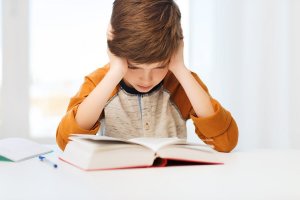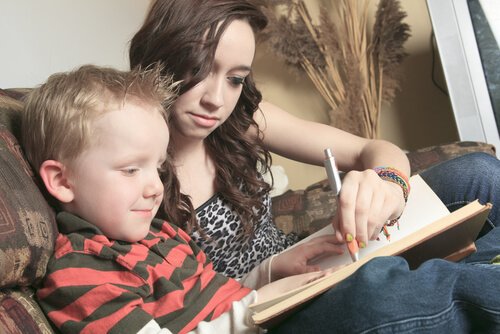5 Reading Problems in Children

Reading is the process by which you understand certain information through written language. However, sometimes kids don’t understand this information properly. These are due to reading problems.
These problems can be caused by several things. For example, these could be environmental, language, or speech problems. What are the most common reading problems in children? How can we as parents help?
Signs pointing to reading problems in children
There are signs that can indicate your child has reading problems. For example, he might have trouble understanding and following tasks. In addition, he might have a hard time remembering what someone has just told him. He may also have difficulty mastering skills such as reading, spelling and writing.
In addition, these children have trouble controlling their temper and identifying words. In some cases, they may have the tendency to write numbers or words backwards.
What are the main reading problems in children?
There are many conditions that can affect children’s ability to read. Among these reading problems are:
1. Dyslexia
This learning difficulty is very common. Children with this condition have difficulty recognizing letters. In addition, they may have trouble rhyming and pronouncing words that are new to them.
On the other hand, they may forget words that they’ve previously seen. They could also omit them and not know where to put them.
Dyslexia can affect writing, spelling and speaking skills. However, the fact that children suffer from this problem doesn’t mean they aren’t intelligent. In fact, there are many people with this disorder that are very successful in life.

2. ADHD
This problem is known as Attention Deficit Hyperactive Disorder (ADHD). It can make it difficult for children to concentrate on reading.
In addition, kids with this problem can be restless and start playing with everything because they feel frustrated. They can even behave badly in the classroom to hide the fact that they don’t know how to do a task.
3. APD
This is Auditory Processing Disorder (ADP). It affects children’s ability to process the information they hear. Therefore, this may cause them not to understand what another person is saying.
On the other hand, children with this disorder have trouble pronouncing new words. In addition, they have trouble differentiating between the sounds of the letters B and D.
4. Reader delay
Generally, it appears in children between ages 6 and 8. It shows up as a delay in acquiring the skills and abilities needed for reading and writing.
5. Visual difficulty
Kids with this disorder have difficulty differentiating letters and forms. They may also not be able to see them in the right order.
“There are signs that can indicate your child has reading problems. For example, he might have trouble understanding and following tasks.”
How to recognize causes of reading problems in children
To know the causes of reading problems in children, here are some tips:
- Talk to the teacher. He could tell you the difficulties your child has that are affecting his learning.
- Request an educational evaluation. If your child goes to public school, you can get other resources to help with the reading difficulty.
- Talk to your doctor. Tell him what you’ve seen at home or what the teacher has noticed. That way, he can rule out any problems.
- Take your child to a specialist. This will determine if you have any learning or attention difficulties.

How to help your child
Even if you’re not sure what caused your child’s reading problems, there are ways you can help.
For example, it’s important to carefully observe your child’s behavior. We also recommend reading out loud together. This will help reinforce his skills.
Also, constantly congratulate your child for trying his hardest. Help him understand the importance of continuing to practice. Finally, try to keep books and magazines at home that your child likes.
In conclusion, reading problems in children can be very frustrating. However, with parents’ help and support, your child can overcome these difficulties and become a good reader.
All cited sources were thoroughly reviewed by our team to ensure their quality, reliability, currency, and validity. The bibliography of this article was considered reliable and of academic or scientific accuracy.
- Alegría, J. (1985). Por un enfoque psicolingüístico del aprendizaje de la lectura y sus dificultades. Infancia y aprendizaje, 8(29), 79-94. https://www.tandfonline.com/doi/abs/10.1080/02103702.1985.10822061
- de Ramírez, R. A. (2000). Dificultades de aprendizaje de la lectura y la escritura. Educere, 4(11), 147-150. https://www.redalyc.org/pdf/356/35601102.pdf
- Sánchez, E. (1990). Estrategias de intervención en los problemas de lectura. Desarrollo psicológico y educación, 3(1), 139-153. http://www.cucs.udg.mx/avisos/Martha_Pacheco/Software%20e%20hipertexto/Antologia_Electronica_pa121/Palacios-cap8.PDF
This text is provided for informational purposes only and does not replace consultation with a professional. If in doubt, consult your specialist.








